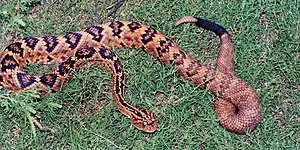Crotalus totonacus
Crotalus totonacus ist eine Art der Klapperschlangen (Crotalus), deren Verbreitungsgebiet sich von Mexiko über Mittelamerika erstreckt. Bis 2004 wurde diese Art als Unterart der Schauer-Klapperschlange (C. durissus) geführt.
| Crotalus totonacus | ||||||||||||
|---|---|---|---|---|---|---|---|---|---|---|---|---|

Crotalus totonacus | ||||||||||||
| Systematik | ||||||||||||
| ||||||||||||
| Wissenschaftlicher Name | ||||||||||||
| Crotalus totonacus | ||||||||||||
| Gloyd & Kauffeld, 1940 |
Merkmale
Crotalus totonacus ist eine relativ große Art der Klapperschlangen mit einer Körperlänge der ausgewachsenen Individuen von über 1,50 Metern. Das längste bekannte Exemplar war 1,665 Meter lang.[1]
Verbreitung
Das Verbreitungsgebiet der Schlange erstreckt sich vom nordöstlichen Mexiko im zentralen Nuevo León durch das südliche Tamaulipas, Nord-Veracruz, das östliche San Luis Potosí und Nord-Querétaro.[1]
Literatur
- J.A. Campbell, W.W. Lamar: The Venomous Reptiles of the Western Hemisphere.Comstock Publishing Associates, Ithaca and London 2004, ISBN 0-8014-4141-2.
Weblinks
This article is issued from Wikipedia. The text is licensed under Creative Commons - Attribution - Sharealike. The authors of the article are listed here. Additional terms may apply for the media files, click on images to show image meta data.